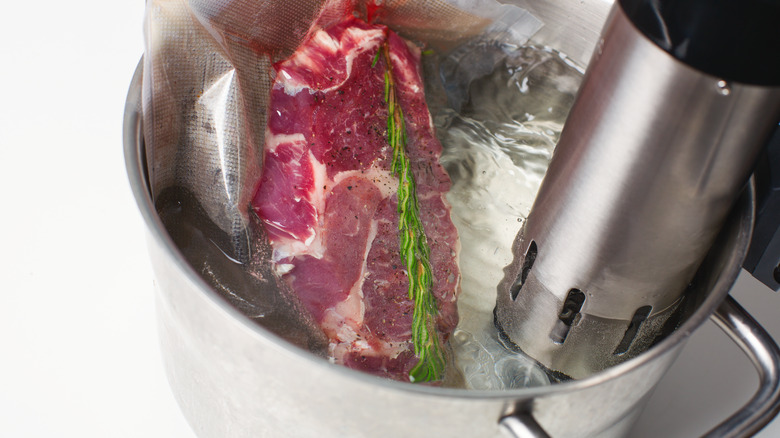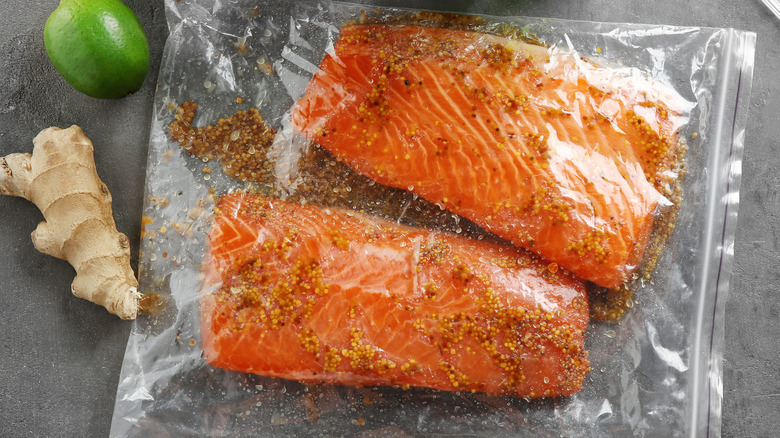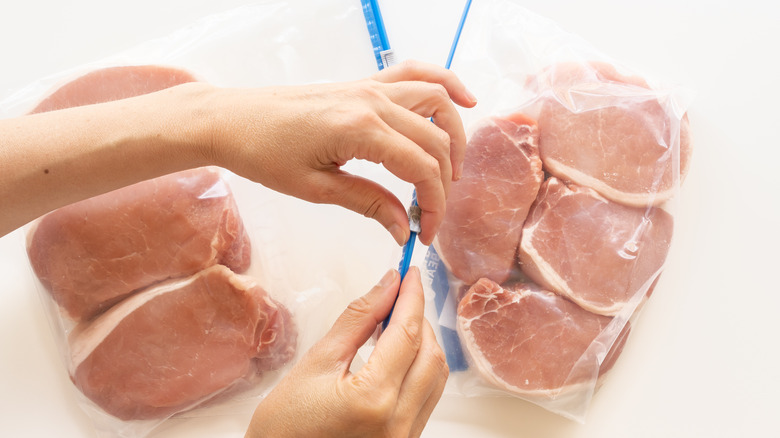Is It Safe To Use A Ziploc Bag For Sous Vide?
So you treated yourself to an immersion circulator to try out a cooking method professional chefs adore — sous vide. But this special tool that keeps the water moving and at a consistent temperature isn't everything you need for sous vide.
Along with the immersion circulator, you'll also need a way to vacuum seal the food. After all, sous vide means "under vacuum" in French (via SousVide Supreme). Once you've splurged on a circulator, you might hesitate to spend any more on a fancy vacuum sealer or the special single-use bags they require. So, is there a cheaper way? Yes, and it's likely in your kitchen drawer right now — the trusty zip-top plastic bag.
If boil-in-bag rice or steam-in-bag vegetables give you pause, you might be wondering if cooking sous vide in a regular zip-top plastic bag is safe. Will the bag melt? Will heating the plastic release hazardous chemicals into your food?
Not all zip-top bags are safe for sous vide
Dr. Don Schaffner of Rutgers University is quoted saying during an interview with AllRecipes.com, "there are risks for cooking sous vide, but I don't consider using zip lock bags high on the list of what those risks are." As somebody who has served on the World Health Organization, the U.S. National Academy of Sciences, and the Food and Agriculture Organization (FAO), his expertise on the matter is well-respected.
The real enemy of safe sous vide isn't the chemicals used to make plastic, it's the unintentional exposure to air. To properly sous vide, the circulating, temperature-regulated water must be in contact with all surfaces of the submersed food, evenly exposing them to the heat, in order to reduce the risk of bacterial growth (via F. Carlin's 2014 article on the microbiology of sous-vide products).
That being said, it's important for the bag to be vacuum sealed, and the type of zip-top bag you use does make a difference. Inexpensive bags may contain harmful BPA and phthalates, which can leach out of these flimsy bags when heated, according to Healthline. Fortunately, reputable brands like Ziploc and Glad are made from polyethylene plastic (PEP) and don't contain any PVC or BPA.
You can check the box to make sure the bags you're purchasing are rated microwave-safe. If they are, then you can use them for sous vide, too.
How to safely use a resealable bag for sous vide
If you don't have a vacuum to remove the air from the bag, you can use the "water displacement method" to properly remove the air from a zip-top bag. The water displacement method uses the pressure from the water to force the air out of the plastic bag as it is submerged, according to Brittanica.com. Once the air is out, you can then seal the top of the bag to achieve the desired effect.
To do this properly, according to immersion circulator manufacturer Anova, place the ingredients in the bag and seal all but the last inch of the closure, so the air can escape. Submerge the bag slowly into the water while massaging the top of the bag to help the air escape. Then, when your food is fully submerged, zip the top the rest of the way closed to form the vacuum. To keep your bag submerged while cooking, you can use a binder clip or clothespin to help avoid exposing your dish to air or blocking the circulator's pump.
On top of being an inexpensive option, opting for a zip-top plastic bag for sous vide has an added eco-friendly benefit you won't get from vacuum seal bags — reusability (via SousVide Hub). Once you're done cooking, you can wash and dry the bag to use again.


